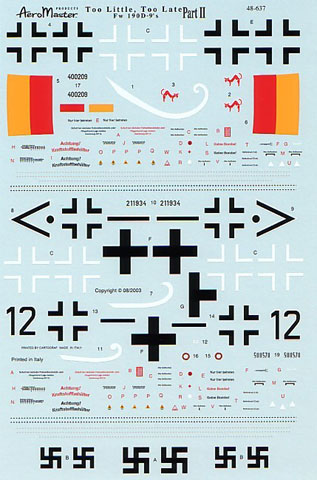|
S u m m a r y
|
| Catalogue
Number: |
AeroMaster decal sheet
48-637 and 32-013 “Too Little, Too Late, Fw 190D-9’s” Part 1 |
| Scale: |
1/32 and 1/48 |
| Contents and Media: |
Double-sided full colour
letter-sized instructions plus notes sheet; 1 x full-size decal
sheet (2 x decal sheets in 1/32 scale releases. |
| Price: |
48-638 USD$9.00
from Aeromaster Website
32-014 USD $10.00 from Aeromaster Website |
| Review Type: |
FirstLook |
| Advantages: |
Perfect register, thin
carrier film, full stencil data; |
| Disadvantages: |
|
| Recommendation: |
Recommended |
Reviewed by Rob Baumgartner

"Too Little, Too Late" 1/48 & 1/32 Fw 190D-9 Decals are available online
from Squadron.com
The third part in AeroMaster’s 1/48th scale series on the Fw 190D-9 is
sheet number 48-638.
As usual it covers three aircraft on an A4 size instruction sheet.
In 1/32 scale the kit is recommended for Hasegawa. Although recommended
for the Tamiya and Dragon kits in 1/48 scale, it is the former that the
bands and spiral have been sized for.
The subjects on this release are:
 Fw
190D-9 of I/JG301 in the spring of 1945. Fw
190D-9 of I/JG301 in the spring of 1945.
Flown by Feldwebel Hagen Forster.
This is a fairly standard machine that is only brightened up by the red
and yellow RVD bands. Added interest also revolves around a personal
marking of a cat that may or may not have been applied. AeroMaster supply
three decals of this cat including one in a reversed attitude.
Upper surface colours are given as RLM 75 Grey-Violet and RLM 83 Dark
Green over RLM 76 Light Blue undersurfaces. A white spiral is supplied for
the black spinner as well as a fictitious W.Nr. for the tail.
The standard black outline B4 Balkenkreuze is displayed on the fuselage
and wing undersurfaces with the white B6 versions appearing on top. The
Hakenkreuze on the tail is of the 420mm H3 type.
Fw 190D-9 of II/JG26 in March 1945
A more interesting machine is this example, which had been much
photographed after the war.
Apparently W.Nr. 211934 belonged to the Geshwader Technical Officer. A
careful study of the photographs shows that it belonged to a previous
owner, as there is a painted out area under the chevron.
The machine is given as finished in RLM 75 Grey-Violet and RLM 83 Dark
Green over the RLM 76 Light Blue undersurfaces. AeroMaster also suggest
the possibility of RLM 82 Light Green appearing on the wing. Mottling of
both of the upper surface colours appears on the fuselage sides as well as
what appears to be a “touch up” using primer on the port fuselage hatch.
Thus part of the lower left arm of the fuselage Balkenkreuze should be
painted over. A colour photo on page 20 of the Monogram “Close Up” shows
this very well.
National markings consist of the standard B6 white outline Balkenkreuze on
the upper wings and the B1b 900mm solid black version underneath. The
larger 530mm H3 Hakenkreuze is represented on the tail and a white spiral
is evident on the black spinner.
Fw 190D-9 of 6. Staffel, II/JG 6, WNr. 500570
There should be no problems with getting information on this well
documented machine. The pilot surrendered his aircraft to the U.S. 10th
Reconnaissance Group on May 8th, 1945.
Despite the contrast of the fuselage number to the Balkenkreuze as seen in
the Squadron/Signal “Walk Around” photos, the aircraft is in fact “black
12”. This is confirmed by a colour photograph, which appears in the
Monogram “Close Up” on the Dora.
AeroMaster give the camouflage colours on the fuselage as RLM 81 (AM
accidentally printed RLM 83) Brown-Violet and RLM 82 Light Green. The
lower fuselage is painted in the so-called “RLM 84” Green-Blue. The rudder
is an exception and carries a finish of RLM 76 Light Blue.
It’s the wings of this aircraft that really make for some fascinating
study.
The upper surfaces of the wings are stated as being in RLM 75 Grey-Violet
and RLM 77 Light-Grey.
There is growing opinion that the RLM 77 may have been RLM 76.
The underneath of the fuselage is depicted in natural metal. Under the
wings we see “RLM 84” with RLM 76 ailerons. Some of the panel joins have
evidence of primer and the undercarriage doors are depicted as painted in
a “brownish-green” colour.
An alternate take on this area comes from analysis extracted from the
Experten Decals book 48-1.
Their view is that the undercarriage doors where tarnished natural metal
and that part of the underside of the starboard wing near the tip was RLM
76.
It’s good to see AeroMaster acknowledge this possibility and give another
interpretation to the photos as they see it.
The common white B6 Balkenkreuze was applied to the to wing upper surfaces
and the fuselage wears the standard B4 black outline type. The lower wings
bare the simplified B1b but on the starboard side it appears to have not
been finished as one arm is missing. AeroMaster correctly show this on
their decal sheet.
As usual, the decals are printed in perfect register with good colour
density.
Stencil data is always welcome and here we have enough for two aircraft.
The lettering is legible and I especially like the “hand painted” decal
that is used to show the primer applied around the lifting holes on the
rear fuselage of “Black 12”.
Another good effort from AeroMaster and one that will please many Dora
fans.
Recommended
Review Text Copyright © 2002 by
Robert Baumgartner
Page Created 05 October, 2003
Last updated
05 October, 2003
Back to
HyperScale Main Page |
Home | What's
New | Features
| Gallery |
Reviews | Reference
| Forum
| Search